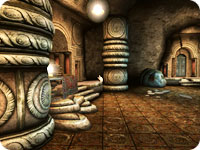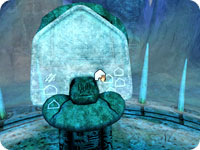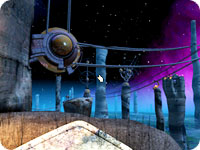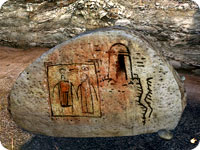The Mac Connection
Myst and the Mac have been intimately connected since the release of the first Myst game, which was developed on that platform. Miller notes: “I prefer the Mac for anything I do, including gaming. I’ve been a Mac user since my first 128K Mac in 1984.”
He currently uses a PowerBook at the office and a Dual Processor Power Mac G5 at home, where he handles video production for the Myst games. Also at home, a G4 Power Mac streams video to his TV, an iBook handles music chores for the stereo and his daughters use an iMac.

Cyan Worlds came into existence in 1987, when Rand and Robyn Miller began developing The Manhole, a children’s title that in 1988 became the first computer game published on CD-ROM. Players followed a rabbit down a manhole and found themselves in a fantastic world that they were encouraged to explore.
Cosmic Osmo and the Worlds Beyond the Mackerel was published in 1989, followed in 1992 by Spelunx and the Caves of Mr. Seudo. Both games continued the idea of journeying to strange new worlds and sparking children’s imaginations.
The Miller brothers wanted to try something more ambitious, however, and set about creating Myst, a project that started in 1991 when artist Chuck Carter and audio engineer Chris Brandkamp joined the team. Cyan, as the company was known for the first 10 years of its existence, set out to build not just a game but a rich, interactive experience with its own unique back story.
“Robyn and I were inspired by fictional works that went beyond the story, revealing histories that implied much larger worlds,” Miller recalls. “Books like The ‘Lord of the Rings’ or movies like ‘Star Wars’ seem to just be brief windows into much larger worlds. That kind of depth made the fictional worlds seem real and believable.”
The Start of Something Big
“We were shocked at how well it was received,” Miller says of Myst’s incredible sales success, which eventually added up to 12 million copies. It was the top-selling computer game of all time until The Sims came along, proving along the way that such entertainment doesn’t have to be violent to be appealing. You can now even play it on your iPhone or iPod touch.
While the point-and-click interface may seem limiting in light of today’s technology, back then it was the only way the Miller brothers could create an exotic world full of wondrous sights and sounds. Millions of players loved the fact that Myst simply dropped you on a deserted island at the beginning, with no idea why you were there, and let you figure out what to do next. The addition of live-action video (Rand plays Atrus and Achenar while Robyn is Sirrus) enhances the immersive feeling.
In the same way Doom invented the first-person shooter genre, Myst had ushered in the adventure puzzle genre. While others tried to imitate their achievement, the Millers took their time creating Myst’s sequel, Riven, which came out in 1997. The first Myst novel, “The Book of Atrus,” saw publication in 1995, however, which gave fans something to do while biding their time for the next installment in the series. It and two other books, “The Book of Ti’ana” (1996) and “The Book of D’ni” (1997), flesh out the series’ back story.
The world of Myst also ventured into comic books, but Dark Horse’s “The Book of the Black Ships” was cancelled after the first issue came out because Cyan did not like the mini-series’ direction.
Closing Out the Series
Robyn Miller left Cyan after Riven’s publication and Rand expanded the company’s name to Cyan Worlds, reflecting his desire to work on more than just Myst. In fact, he had no plans for another Myst sequel until Presto Studios approached him with the proposal for what would become Myst III: Exile. That game, released in 2001, followed on the heels of realMyst, which offered the same gameplay as the original Myst but featured improved graphics and audio, a hint system and maps.
Myst IV: Revelation was developed and published by Ubisoft, which had published Presto’s Myst III. While it used the same point-and-click interface as the original Myst, players could pan 360 degrees around any scene, a breakthrough that first appeared in Myst III. Myst IV took the effect further by introducing fully animated scenes full of moving water, swaying trees, flying birds and more.
To learn more about the story of the Myst games, please read “Myst for D’ni(s),” the sidebar that accompanies our article about Myst IV.

A Lost Civilization. Explore the abandoned underground D’ni city.

Primitive Communications. One of the Slates in action. Drawing a symbol on it may trigger an event.

The Sky’s the Limit. One of the new Ages found in the game.

Pictogram. Eventually these drawings will make sense.
- Mac OS X version 10.2.8 (10.3.9 or higher recommended)
- 1GHz PowerPC G4 processor (1.6GHz recommended); Not compatible with Intel Macs
- 256MB of RAM (512MB recommended)
- 32MB video RAM
- 4.5GB hard disk space
- 4X DVD Drive
